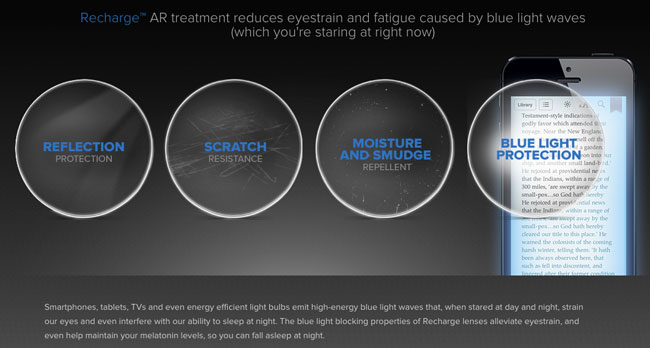I'm pretty sure all of my colleagues have taken all of the good puns for themselves when addressing this topic, so, I'm just going to jump right ahead on into it. Other articles here, as well as over at 20/20, have already covered the ubiquity and potential dangers of HEV light, that light emitted in the 400-500nm range in the visible spectrum. Rather than assess this threat, though, I'm going to begin looking at the lenses designed to help prevent it, assessing them not only from an optician's point of view, but from the consumer side of things as well.
I'm going to begin this series by looking at HOYA's Recharge, which, in the interest of full disclosure, is the lens I'm wearing in my glasses right now. The lens is an upgrade of Hoya's successful EX3 AR, which boasts an exceptional scratch resistance and superior cleanability. With the addition of the Recharge properties, the lens becomes an efficient blue-blocker, reducing blue light by about 30 percent.
When I first got the lenses about a year ago, I was eager to give them a go round; as I've mentioned before—and as is probably apparent anyway, if you've been reading OH for a while—I essentially live in front of a computer (I'm currently working with some folks at Utopia Planetia to engineer a way for me to live inside of my computer for efficiency's sake, but that's another story). As a result, my eyes are constantly getting bombarded with bright light from backlit devices, and I was beginning to feel the strain. As a result, I was happy for the opportunity to not only play with new technology, but take a stab at something that would potentially alleviate what was becoming a big nuisance.

Image from hoyavision.com/idsinglevision
As it turns out, Recharge was the lens I was looking for. Within a week's time, I'd already noticed the difference during my marathon writing sessions. My eyes didn't feel as overtaxed and raw afterwards, and I wasn't experiencing the troubling "zone out" effect that resulted in me asking our doctor to refract me and determine if I had developed presbyopia (again, in the interest of full disclosure, I was 29 at the time). Not only is focusing on the screen easier now, but it's actually permitted me to extend my writing sessions even longer than before (which, from my wife's perspective, isn't necessarily a good thing). Another added benefit that I noticed was that, in the days and weeks after beginning to wear my recharge lenses regularly, I noticed an improvement in the ease and quality of my sleep. In less than a month, I went from a hardcore insomniac, popping Tylenol PM and playing Zelda until the twilight hours of the morning, to being able to more or less doze off at an appropriate time and enjoy a (relatively) restful night's sleep. Though I haven't subjected myself to any guinea-pig levels of experimentation, I'm willing to take an educated guess and hypothesize that it's because my overexposure to blue light was helping to suppress my levels of melatonin, a hormone responsible for the regulation of circadian rhythms.
In the interest of fairness, there is one aspect of Recharge that I feel I must address for any optician reading this who's now eagerly dialing their Hoya rep for further information: Cosmetics. While a large part of the appeal of ARs is to help patients improve the appearance of their eyeglasses, in my own personal experience, I've encountered a significant number of individuals who feel that Recharge actually diminishes their appearance. As a matter of fact, Recharge is the only AR I've sold in my four-odd-years in the optics industry for which I've had a statistically significant number of patients ask for a refund or exchange. This is due to two reasons: The first, and less significant factor, is that the lens shows up with a slight brown cast in photos, lighter but not dissimilar to the brown lenses often prescribed in the 1970s. Few patients have had an issue with this, but it's not an uncommon complaint, either. The second, and most often cited reason, is that the residual color is somewhat more prevalent on Recharge than on many other ARs, and the patient frequently appears as though he or she has a blue/purple flash coating on his or her lenses. Though the patient can't see this effect for him or herself, it is noticeable to friends, colleagues, and family members, and I've had multiple returns from patients either frustrated or embarrassed from comments and remarks they've received from others. Now, I'm not talking a fifty-percent return rate here, or even 25; but it is enough that I have begun keeping a demo lens in my desk to show patients the difference between EX3 and Recharge so they can make the decision for themselves. Knowing the health benefits and dangers of blue light, many patients have still begun opting for EX3 due to the cosmetic effects of Recharge. I can't say these are completely invalid complaints; I've experienced similar issues. However, I still thoroughly stand behind Recharge as a phenomenonal, beneficial AR, and I've found a solution to my issue that I feel will also benefit any practice that decides to default to Recharge as their go-to AR.
I recently obtained a pair of dress glasses with EX3 to wear out with friends and family, to social gatherings, or when I know I'm going to have my picture taken. I wear my Recharge lenses the rest of the time. Problem solved. I think a similar principal can be applied in most offices: One pair for work, one for social life. The patient gets the highest quality of eye protection and cosmetics available; and, of course, you get a two-pair sale.

Preston Fassel was born in Houston, Texas and grew up between St. Charles, Missouri and Broken Arrow, Okla.
In 2009, Preston graduated Summa Cum Laude with a degree in Liberal Arts. In 2011, he graduated Cum Laude from Sam Houston State University with a Bachelor's of Science.
Preston currently works as an Optician in the Houston area. His interest in the history of eyewear goes back to his time in high school, when he developed an interest in all things vintage.
In addition to his writing for The 20/20 Opticians Handbook and 20/20 Magazine, Preston is a featured writer for Rue Morgue Magazine, where he reviews of horror and science-fiction DVDs. His fiction writing has been featured three times in Swirl magazine, the literary arts journal of Lone Star College and Montgomery County. He is the author of the definitive work on the life of British horror actress Vanessa Howard, Remembering Vanessa, which appeared in the Spring 2014 edition of Screem Magazine.













